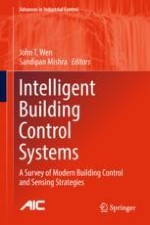2018 | OriginalPaper | Chapter
2. Architectures and Algorithms for Building Automation—An Industry View
Authors : Petr Stluka, Girija Parthasarathy, Steve Gabel, Tariq Samad
Published in: Intelligent Building Control Systems
Publisher: Springer International Publishing
Activate our intelligent search to find suitable subject content or patents.
Select sections of text to find matching patents with Artificial Intelligence. powered by
Select sections of text to find additional relevant content using AI-assisted search. powered by
